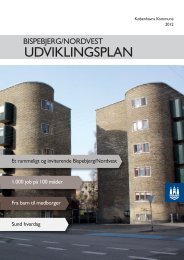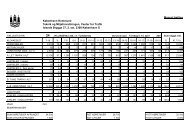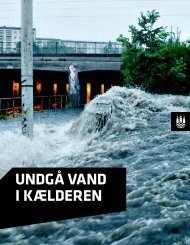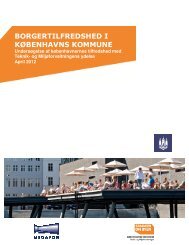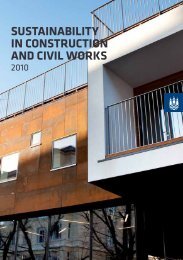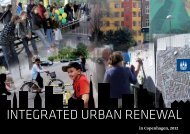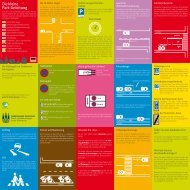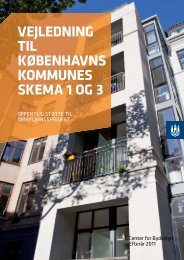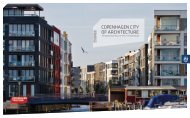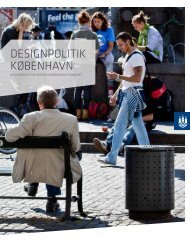The City of Copenhagen's Bicycle Strategy 2011-2025
The City of Copenhagen's Bicycle Strategy 2011-2025
The City of Copenhagen's Bicycle Strategy 2011-2025
You also want an ePaper? Increase the reach of your titles
YUMPU automatically turns print PDFs into web optimized ePapers that Google loves.
36%<br />
<strong>of</strong> all trips to work or educational<br />
institutions in Copenhagen are by bicycle,*<br />
equalling 0 tonnes <strong>of</strong> C02 emissions.<br />
This high percentage <strong>of</strong> the modal share is<br />
a key element in the declared goal <strong>of</strong> making<br />
Copenhagen<br />
CO2-neutral<br />
by <strong>2025</strong><br />
*Average 2008-2010<br />
A BETTER<br />
BICYCLE CITY<br />
A MORE<br />
LIVEABLE<br />
CITY<br />
6<br />
A bicycle-friendly city is a city with more space, less noise,<br />
cleaner air, healthier citizens and a better economy. It’s a city<br />
that is a nicer place to be in and where individuals have a<br />
higher quality <strong>of</strong> life. Where accessibility is high and there is<br />
a short route from thought to action if one wants to head out<br />
into nature, participate in cultural or sports activities or buy<br />
locally. <strong>Bicycle</strong> traffic is therefore not a singular goal but rather<br />
an effective tool to use when creating a liveable city with space<br />
for diversity and development.<br />
Fortunately, it pays <strong>of</strong>f to invest in urban cycling. Increased<br />
cycling levels give society less congestion, fewer sick days,<br />
longer life expectancy, less wear and tear on the roads and less<br />
pollution. Cycling initiatives are also inexpensive compared<br />
with other transport investments.<br />
<strong>The</strong> eyes <strong>of</strong> the world are already focused on Copenhagen – <strong>The</strong><br />
<strong>City</strong> <strong>of</strong> Cyclists. By continuing the ambitious work towards<br />
becoming the world’s best cycling city, we maintain the many<br />
positive stories about the city. Stories that brand Copenhagen<br />
as a liveable, innovative, sustainable and democratic city with<br />
a political will to lead the way in the battle for an improved<br />
quality <strong>of</strong> life for the citizens. By aiming to be the best in the<br />
world we can show the way for other cities around the world<br />
and raise the bar for what is possible in the area <strong>of</strong> urban<br />
cycling.<br />
Copenhageners choose the bicycle because it’s the fastest and<br />
easiest way to get around. Period. If the numbers <strong>of</strong> cycling<br />
citizens are to increase it is all about making the bicycle the<br />
fastest and easiest way to get around for even more citizens<br />
than today.<br />
This is not possible without a strong prioritising <strong>of</strong> bicyclefriendly<br />
infrastructure and a will to think out <strong>of</strong> the box. <strong>The</strong>se<br />
are therefore the two central principles in the bicycle traffic<br />
area: prioritising and innovation.<br />
PRIORITISING<br />
<strong>The</strong> cycle tracks <strong>of</strong> Copenhagen are already under pressure<br />
during rush hour. It is necessary to give more space to cyclists<br />
on the main arteries. In order to increase the sense <strong>of</strong> security,<br />
make it possible for people to ride at their preferred speed<br />
and, not least, to make it more attractive for those who are<br />
too insecure to cycle today. In some places the existing cycle<br />
tracks will be widened, in other places alternative routes<br />
will be necessary to move some <strong>of</strong> the bicycle traffic away<br />
from the congested routes. Infrastructure expansion will be<br />
accompanied with campaigns focused on more considerate<br />
behaviour in traffic.<br />
”Travel times are a central parameter<br />
for competitiveness, regardless<br />
<strong>of</strong> which type <strong>of</strong> transport you are<br />
dealing with.”<br />
It is therefore necessary to improve travel times by bicycle<br />
compared to other transport forms. It requires prioritising<br />
ambitious short cuts like tunnels and bridges over water,<br />
railways and large roads. In addition, it requires many small<br />
speed improvements, including allowing contraflow cycling on<br />
one-way streets, allowing cycling across squares, implementing<br />
more Green Waves for cyclists, etc. Finally, traffic calming - on<br />
quiet streets near schools, for example - is also necessary if the<br />
bicycle is to have a serious advantage in traffic.<br />
INNOVATION<br />
One <strong>of</strong> the unique things about Copenhagen is our cycle tracks.<br />
Working to expand and develop our cycle track network must<br />
continue. If we are to encourage many new cyclists to get onto<br />
their bicycles it is crucial that we’re open to new concepts.<br />
Regardless <strong>of</strong> whether it is infrastructure or other types <strong>of</strong><br />
solutions. It could be, for example, making certain streets oneway<br />
for cars in order to create improved space for better cycling<br />
conditions, new types <strong>of</strong> bicycle parking – including cargo bike<br />
parking – and initiatives that make streets with cobblestones<br />
into attractive cycle routes.<br />
WHAT<br />
NEEDS TO<br />
BE DONE<br />
<strong>City</strong> life<br />
Comfort<br />
Speed<br />
Sense <strong>of</strong><br />
security<br />
”We will also have to work even<br />
more with new solutions that include<br />
technology, communication<br />
and partnerships. For example, IT<br />
solutions must be integrated into<br />
both bicycles and the roads.”<br />
Infrastructure like footrests at intersections and air pumps<br />
have both a practical and a communication value. Partnerships<br />
within the municipality should put the bicycle onto the<br />
agenda as a way to improve health and integration. In addition,<br />
external partnerships with companies, shopping districts,<br />
public transport providers, neighbouring municipalities, etc.,<br />
ensure optimal effect and anchor the various initiatives. Finally,<br />
it is necessary to work systematically with communication<br />
campaigns aimed at specific target groups with the potential<br />
to cycle more.<br />
SAFE, QUICK, COMFORTABLE AND LOADS OF CITY LIFE<br />
<strong>The</strong>se keywords should define cycling in Copenhagen if we<br />
are to achieve our goal <strong>of</strong> becoming the world’s best bicycle<br />
city. <strong>The</strong>refore, each <strong>of</strong> these keywords is a theme on the<br />
following pages. We’ll give examples <strong>of</strong> how each <strong>of</strong> them<br />
can be improved through prioritising and innovation. <strong>The</strong><br />
complete recipe for becoming the world’s best bicycle city,<br />
including the specific political goals, is summed up at the end<br />
<strong>of</strong> this document.<br />
First, a few statistics about Copenhagen – <strong>The</strong> <strong>City</strong> <strong>of</strong> Cyclists.<br />
7



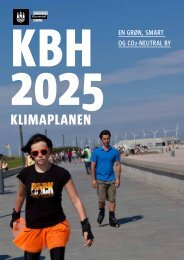
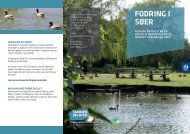
![Lokalplan 301[1] - Itera](https://img.yumpu.com/49288321/1/184x260/lokalplan-3011-itera.jpg?quality=85)
